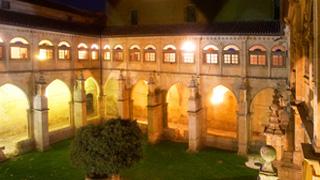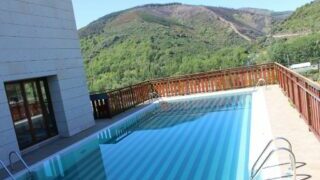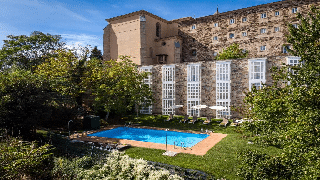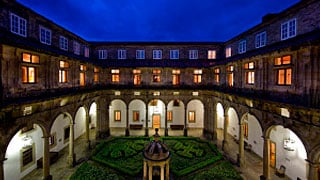Do not hesitate to give us a call. Our expert team will be happy to help you!
Level

Covering over 500km of the Camino de Santiago, our guided bike tour from Burgos is the perfect choice for pilgrims wishing to discover the true diversity of Spain!
This beautiful guided bike tour takes pilgrims on a journey through medieval Spain, across the legendary meseta (the desert-like interior of Castilla y León), through holm oak forests and wheat fields, all the way to the verdant mountains of Galicia, famous for its seafood – especially octopus! Along the way, you will discover historic cities including León, Astorga, Ponferrada and of course, Santiago de Compostela itself.
On this active holiday, with the support of our experienced Bike Spain guide, you will tour the entire Camino from Burgos by bike and van transfers. You will cycle the most beautiful stretches of the ancient pilgrimage route, enjoy awe-inspiring scenery, stopover in carefully-renovated historical buildings, converted into luxury hotels, and sample the finest food and wines of Castile-Leon and Galicia.
Day 1: Burgos
Arrival day
Accommodation: AC Hotel Burgos
Meals included: Dinner
Welcome to Burgos, and your guided Camino de Santiago bike tour!
We’ll pick you up from your hotel in Madrid, and travel by van up to the city of Burgos. Founded in 884, the ancient city of Burgos is steeped in Camino history, and boasts a majestic cathedral with UNESCO World Heritage Site status.
After the bike fitting and a short city tour, we’ll enjoy a traditional Spanish dinner at a restaurant facing the Cathedral. We’ll also collect our credenciales – the all-important document that certifies our status as official pilgrims.
Day 2: Castrojeriz – Carrión de los Condes
Route: 55.2 km/34.3 miles
Elevation: +273 m/+895 ft
Accommodation: Real Monasterio de San Zoilo
Meals included: Breakfast, lunch and dinner
Your Camino bike tour begins! After breakfast, we’ll depart Burgos and head to the village of Castrojeriz by van, and begin our first cycling route from here. Today’s route takes us across the legendary meseta: the flat, desert-like landscape at the centre of Spain.
We’ll take the twelfth-century Fitero bridge across the Pisuerga River into the province of Palencia, and cycle through an endless sea of golden wheat fields, with the occasional “lighthouse” of a medieval church spire or a stone pigeon coop.
Next, we’ll cross the Canal de Castilla into the town of Frómista, famous for its Spanish Romanesque architecture. From here, we’ll continue across the plains of the meseta and go through several other small medieval villages before stopping for the evening in Carrión de los Condes.
Carrión is the final resting place of Saint Zoilus (Zolio in Spanish), who was executed in Cordoba under Emperor Diocletian (r. 284-305). His relics have been enshrined, along with those of nineteen other martyrs, in the twelfth-century Renaissance Benedictine monastery of San Zoilo de Carrion, our hotel for the night!
Day 3: Carrión de los Condes – Sagahún
Route: 46.1 km/28.6 miles
Elevation: +246 m/+807 ft
Accommodation: Parador de Leon GL
Meals included: Breakfast, lunch and dinner
Today’s stage is another flat ride surrounded by endless golden plains and medieval villages lost in time. The first of these is Calzadilla de la Cueza, tucked away in a basin and hidden from sight almost until we stumble upon it.
Just before reaching Sahagún, the midpoint of the Camino Francés and the endpoint of today’s stage, we’ll cross into the province of León, and the so-called “Leonese desert”. Despite its small size, Sahagún boasts some of the most important Arab-influenced church architecture in Castile, as well as an important Catholic historical heritage, product of its association with the monastic Order of Cluny.
After lunch in Sahagún (during which we’ll have the opportunity to try the local delicacy of leeks), we’ll travel by van to the historic city of León, founded by the Romans in 68 BC and whose cathedral boasts the largest stained-glass windows ever made.
We’ll spend the late afternoon visiting the cathedral and wandering around the quaint streets of the barrio húmedo (known for some of the best tapas bars in Castile). Tonight, we’ll stay at the exclusive five star Parador de León, a beautifully-converted 16th century monastery, complete with cloisters and chapter house.
Day 4: Astorga – Ponferrada
Route: 59.7 km/37.1 miles
Elevation: +805 m/+2641 ft
Accommodation: Parador de Villafranca
Meals included: Breakfast, lunch and dinner
We’ll begin the day with a van transfer from León to the historic town of Astorga, located at the convergence of the Camino de Santiago and the Vía de la Plata. After visiting Astorga’s cathedral, pilgrim hospital and Episcopal Palace (designed and built by Antoni Gaudí), we’ll begin the day’s ride.
From Astorga, the Camino climbs gently up to the foothills of your first mountain pass. Once we’ve reached the top of Foncebadón, we can relax and enjoy the sweeping downhill ride into Villafranca, with gorgeous views of vineyards stretching out endlessly on both sides.
Just outside of Foncebadón, we’ll come across the famous Cruz del Ferro, the highest point of today’s ride and also the highest point of the Camino Francés, where pilgrims traditionally leave a small stone as a symbol of leaving behind their burdens before arriving in Santiago.
Continuing on the Camino, we’ll pass through the medieval town of Molinaseca before finishing the day’s cycle route in the ancient city of Ponferrada, historically a stronghold of the Knights Templar and still dominated by their imposing 12th century castle.
From Ponferrada, we’ll travel by van to the town of Villafranca del Bierzo, where we’ll stay in the renovated, comfortable and modern Parador.
Villafranca del Bierzo was originally founded to provide pilgrims with refuge and sanctuary before beginning the most difficult part of their pilgrimage. The town boasts a long and storied history, and is replete with churches and monuments, testament to its importance as a stop on the ancient Camino de Santiago route.
Day 5: O’Cebreiro – Sarria
Route: 38.1 km/23.7 miles
Elevation: +277m/+908 ft
Accommodation: Parador Monforte de Lemos
Meals included: Breakfast, lunch and dinner
From Villafranca the Camino climbs up to the mountain village of O’Cebreiro, the most demanding ascent of the western Camino Francés. Fortunately, we’ll travel this segment in our van!
The tiny mountain village of O’Cebreiro is our first stop in Galicia. The village holds huge cultural significance for the Camino de Santiago. The 9th century church of Santa María do Cebreiro is one of the oldest and best-preserved along the whole Camino, and is said to house the Holy Grail! Its bells once rang through the mists to guide pilgrims to safety, and the views when the skies are clear are astounding.
From O’Cebreiro, it’s downhill all the way to Sarria. We’ll visit the Benedictine monastery of Saint Julian in Samos, whose foundation dates all the way back to the 6th century, and follow country roads through pine and eucalyptus forests towards Sarria, where we’ll stop to have lunch and soak up the Camino atmosphere.
After lunch, we’ll travel by van to the Parador in Monforte de Lemos, a charming little town with excellent wines.
Day 6: Arzúa – Santiago de Compostela
Route: 44 km/27.4 miles
Elevation: +692 m/+2262 ft
Accommodation: Parador de Santiago GL
Meals included: Breakfast, lunch and dinner
After a quick van transfer to the town of Arzua, we’ll enjoy a final cycle route through the beautiful Galician countryside to your final destination: the Pórtico de la Gloria (“The Façade of Glory”) of Santiago Cathedral! Along the way, we’ll pedal past Lavacolla hill, where medieval pilgrims would tidy themselves up before reaching Santiago. From there it’s on to Monte do Gozo (Mount of Joy), so named because it offers pilgrims their first glimpse of the Cathedral of Santiago.
The official end-point of the Camino in Santiago de Compostela is the Cathedral, located in Plaza del Obradoiro. We’ll take a break in the plaza to celebrate our achievement and soak up the amazing atmosphere. There is something indescribably human about the sight of hundreds of daily pilgrims arriving into the plaza, just as countless others have done over the centuries.
Inside the Cathedral, pilgrims traditionally embrace the statue of St James and visit his tomb. Our next stop is the Pilgrims’ Office, where we can obtain our Compostela pilgrim certificates.
Congratulations on the completion of your pilgrimage to Santiago de Compostela!
Day 7: Santiago de Compostela
Departure day
Meals included: Breakfast
After breakfast, your Camino bike tour from Burgos comes to an end.
Santiago de Compostela has its own airport, and is well-connected with destinations within Spain and in other European countries. Connections by high-speed train are also available (via local train to Ourense). If you require any assistance with your onward travels, please contact our Bike Spain Tours team.
OPTIONAL EXTENSION: As the most important city in Christian medieval Spain, Santiago de Compostela is well worth taking an extra day to explore. Alternatively, we recommend a trip to the “end of the world”: the spectacular Finisterre peninsula. The western-most point in Spain, Finisterre is the traditional end of the Camino de Santiago, where pilgrims would traditionally burn old clothes and cast the ashes into the ocean as a symbol of their purification after their journey.
Hotel AC Burgos – Marriott

The AC Hotel Burgos is one of the best accommodation options in the city: the perfect place to begin your Camino bike tour!
All rooms are light-filled bringing in the natural glow of daylight. Located right in the city center and close to the Gothic Cathedral, the river, and Las Huelgas Monastery.
Hotel Real Monasterio San Zoilo

San Zoilo, a former convent, offers a unique break to unwind in the same rooms various Courts and Councils from Castile’s Kingdom once did.
This repurposed historic building offers 54 comfortable rooms all throughout the Monastery, the gardens or the seminary. There are about 60 different species of trees that make the Real Manasterio of San Zoilo a green oasis.
Parador de León GL San Marcos

Located in Leon’s historical center, directly in the heart of one of the most impressive Roman complexes of the Peninsula.
The convent of San Marcos is one of the greatest architectural gems of the Spanish town of Leon, together with the Cathedral, the San Isidoro Basilica or the Casa Botines. It has now become a Parador and is one of the most important monuments of the Spanish Renaissance.
Parador de Villafranca del Bierzo

Villafranca del Bierzo is a town full of churches, monasteries and convents. Right at the town entrance stands this converted historical building, known as a Parador in Spain.
The leading tourist accommodation in the fascinating El Bierzo district. It is surrounded by mountains covered with cherry and fig trees, slopes dotted with chestnuts, poplars and small farms.
Parador de Monforte de Lemos

The historic site of San Vicente do Pino is located in the uppermost part of the town of Monforte de Lemos.
San Vicente do Pino Monastery and the palace of the counts of Lemos houses the Parador de Monforte. The monastery dates back to the 9th century, although the current structure was built in the 17th century in the neoclassical style.
Parador de Santiago-Hostal Reis Catolicos

The Parador de Santiago is a blend of history, art and tradition. It’s a dream accommodation for pilgrims and the perfect place to end your Camino de Santiago bike tour from Burgos.
The hotel is located in Obradoiro Square near the cathedral, creating an area of spectacular beauty in one of the most visited provincial capitals of the world. A stay at this Parador means a visit to a truly unique and exclusive location.

3.720,00€
Covering over 500km of the Camino de Santiago, our guided bike tour from Burgos is the perfect choice for pilgrims wishing to discover the true diversity of Spain!
Minimum group size for guaranteed departure at this price: 4 people.
Other dates and group size options available upon request.
| Dates | 11 May 2025, 8 Jun 2025, 21 Sep 2025, 12 Oct 2025, Custom dates |
|---|
“First factor was how highly rated Bike Spain has been with previous customers
Second factor was the availability for bike routes in the country we wanted to explore
Third factor was the quality of the bikes, and the experience with the desired routes”
Info
About UsContact Info
Plaza de la Villa 1,
28005 Madrid
+34 915 590 653
info@bikespain.com
